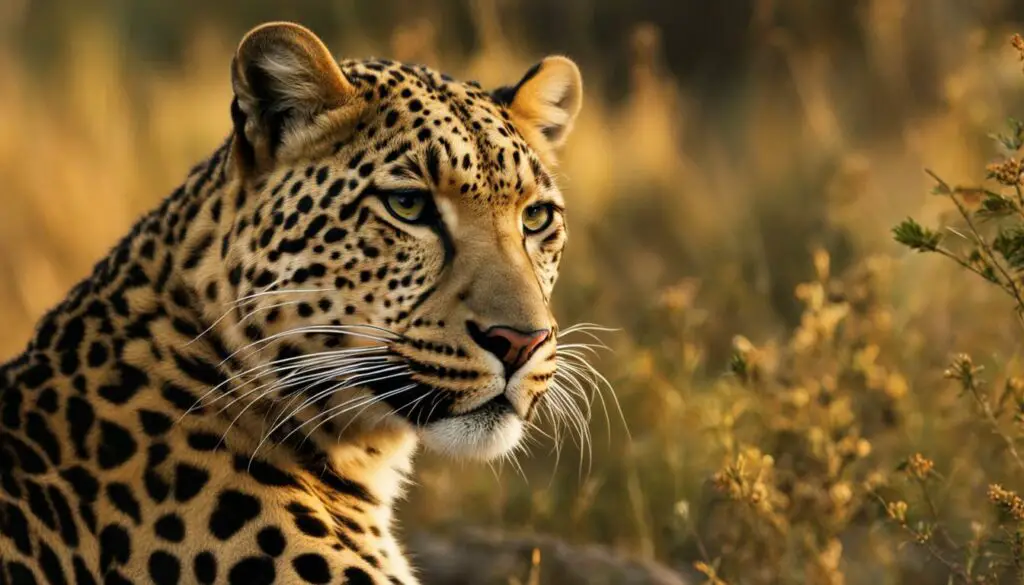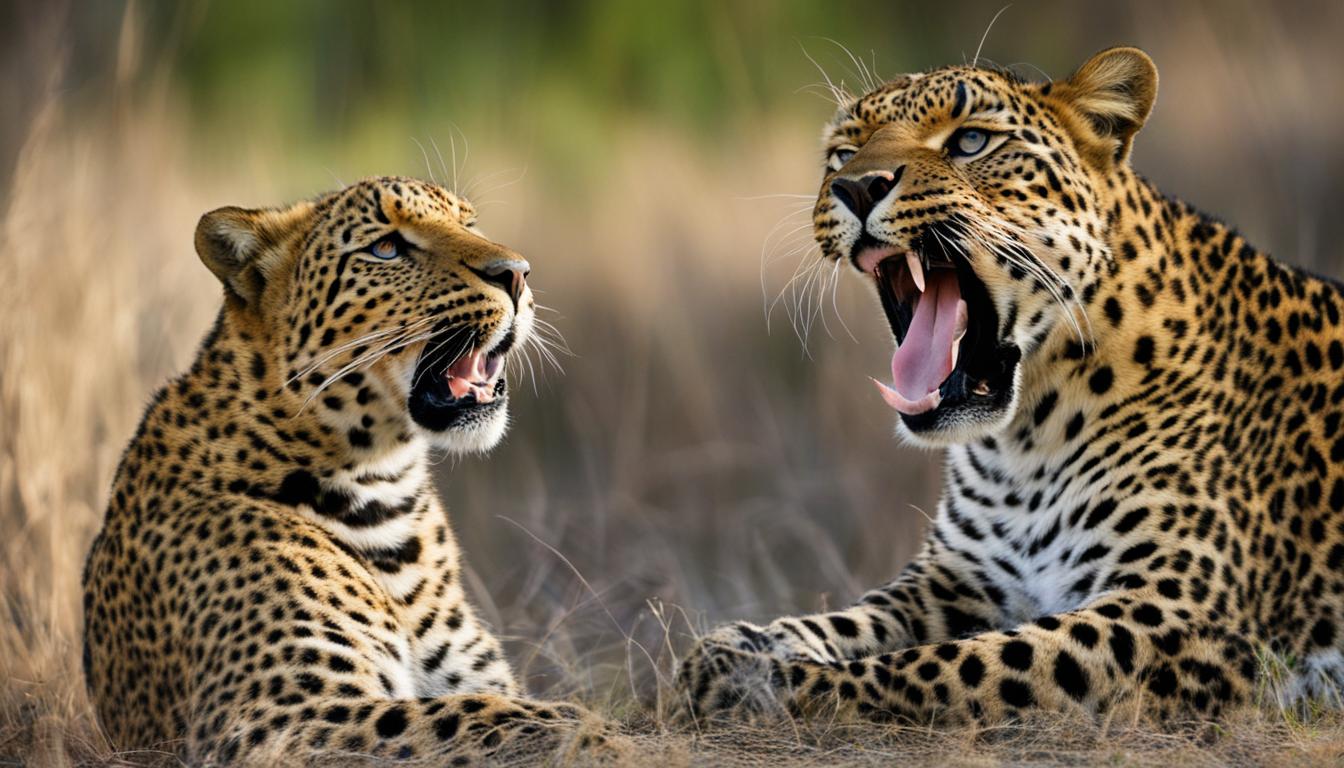Leopards, with their majestic presence and elusive nature, have a unique way of communicating with their fellow leopards. Through various vocalizations and sounds, they convey messages of territoriality, availability for mating, and more.
Leopard vocalizations, encompassing roars, growls, and calls, are a crucial part of their communication repertoire. These distinctive sounds serve different purposes, such as defending territory, attracting attention, and communicating between males and females.
Scent marking is another important communication method employed by leopards. By marking trees, vegetation, and the ground with their urine or anal sac secretions, they leave behind chemical cues that indicate their territory and reproductive availability.
Join us as we explore the fascinating world of leopard communication, uncovering the secrets behind their vocalizations, scent markings, and territorial behavior. Gain insight into the social behaviors and survival strategies of these incredible creatures.
Scent Marking as a Communication Method
Leopards rely heavily on scent marking as a primary communication method. They use their scent glands to leave behind chemical cues through urine or anal sac secretions. By marking trees, vegetation, and the ground, leopards establish their presence and territory, and also communicate their reproductive availability to other leopards. This form of communication is essential for leopards to avoid conflict and establish boundaries.
In addition to urine and anal gland secretions, leopards also rub their cheeks against objects and leave claw marks on tree trunks to release their scent. These actions help distribute their scent and ensure that other leopards can detect and register their presence. When encountering scent markings, leopards perform a flehmen response, which involves curling back their lips and inhaling the scent to gather valuable information about the marking leopard.
Scent Marking as a Communication Method
Scent marking is a highly effective means of communication for leopards, as it allows them to maintain territorial boundaries and avoid direct confrontations with other individuals. Through scent marking, leopards are able to convey their dominance, reproductive status, and overall territory ownership. This method of communication plays a crucial role in the social interactions and survival of leopards in the wild.
To further emphasize the importance of scent marking, let’s take a look at the following table:
| Scent Marking Behaviors | Purpose |
|---|---|
| Urinating on trees, vegetation, and the ground | Establishing territory and reproductive availability |
| Leaving anal gland secretions on objects | Marking presence and asserting dominance |
| Rubbing cheeks against objects | Distributing scent and marking territory |
| Leaving claw marks on tree trunks | Releasing scent and marking territory |
By utilizing these scent marking behaviors, leopards are able to effectively communicate their status and establish boundaries between themselves and other leopards in their environment. This ensures a harmonious coexistence and reduces the likelihood of aggressive encounters.
Leopard Vocalizations and Communication Methods
Leopards possess a wide range of vocalizations and sounds that they utilize to communicate with other members of their species. These vocal cues play an essential role in establishing territory, attracting attention, and facilitating communication between males and females. By comprehending the different vocalizations and their significance, we can gain valuable insights into the social behaviors and survival strategies of leopards.
One of the most distinctive vocalizations of leopards is their roar. Roaring serves as a means of defending territory and asserting dominance. It is a powerful and intimidating sound that can be heard over long distances, effectively announcing a leopard’s presence to other individuals. Alongside roaring, leopards also emit growls, snarls, hisses, and chuffing or puffing sounds, each with its own purpose.
The sawing call is a notable vocalization that is unique to each individual leopard. It resembles the sound of sawing wood and is used primarily to mark and announce territory. This vocalization helps leopards avoid unnecessary conflicts by clearly signaling their presence and territorial boundaries to other leopards in the area. Additionally, leopards employ softer sounds like grunts and mews to communicate with their cubs, fostering familial bonds and ensuring their safety.
In addition to vocalizations, leopards also employ scent marking as a prominent method of communication. This involves using their scent glands to mark trees, vegetation, and the ground with urine or anal sac secretions. By leaving behind chemical cues, leopards convey important information about their territory and reproductive availability to other individuals. The combination of vocalizations and scent marking allows leopards to establish their presence, communicate effectively, and maintain social order within their species.

Leopard Vocalizations and Sounds:
| Vocalization | Purpose |
|---|---|
| Roar | Defending territory and asserting dominance |
| Growl | Expressing aggression or warning |
| Snarl | Signaling aggression and displaying aggression |
| Hiss | Expressing fear or threat |
| Chuffing/Puffing Sound | Attracting attention or showing interest |
| Sawing Call | Marking territory and announcing presence |
| Grunt | Communicating with cubs |
| Mew | Calling and comforting cubs |
Territorial Behavior and Communication
Leopards exhibit specific territorial behavior as a means of communication to establish their home and target range. Through various communication methods, leopards are able to avoid conflict with other individuals and safeguard their territories. Scent marking is one of the primary ways in which leopards communicate their presence and territory. By using their scent glands to mark trees, vegetation, and the ground with urine or anal sac secretions, leopards leave behind chemical cues that convey important information to other leopards. This helps in defining boundaries and reducing the likelihood of confrontations.
In addition to scent marking, leopards also employ vocal cues to communicate with other individuals. Roaring, coughing, and rasping are some of the vocalizations used by leopards to announce their presence and establish their territory. These vocal cues serve as warnings to potential intruders and help in maintaining a peaceful coexistence within their habitat. By clearly conveying their intentions through vocalizations, leopards are able to avoid unnecessary conflicts and maintain a harmonious balance.
Visual displays also play a role in leopard communication. Posturing, swiping with a paw, and flicking their tails are some of the visual signals used by leopards to indicate their presence and territorial boundaries. These visual displays can be effective in conveying messages to other leopards, as they serve as clear indicators of an individual’s intent and readiness to defend its territory. By combining scent marking, vocal cues, and visual displays, leopards are able to establish and maintain their territories, reducing the need for direct confrontations.
| Communication Method | Description |
|---|---|
| Scent Marking | Leopards use scent glands to mark trees, vegetation, and the ground with urine or anal sac secretions. This helps establish territory boundaries and reproductive availability. |
| Vocal Cues | Leopards use vocalizations such as roaring, coughing, and rasping to announce their presence and establish their territory, reducing the likelihood of conflicts. |
| Visual Displays | Leopards employ visual signals like posturing, swiping with a paw, and tail flicking to indicate their presence and territorial boundaries, conveying their readiness to defend their territory. |
In summary, territorial behavior and communication play a crucial role in the life of leopards. By using scent marking, vocal cues, and visual displays, leopards are able to effectively communicate their presence, establish their territory, and avoid conflict with fellow leopards. Understanding these communication methods provides valuable insight into the social dynamics and survival strategies of these majestic big cats.
Leopard Communication in Captivity
In captivity, leopards have limited opportunities to communicate with other leopards. However, wildlife rescue and rehabilitation centers, like the Wildlife SOS Manikdoh Leopard Rescue Centre, provide measures to replicate their natural habitat and enable communication. They create environments with trees, logs, and dense vegetation for leopards to display natural behaviors like scent marking and vocalizations. This allows leopards to communicate with other leopards and establish their own territories, even in a captive setting.
Leopards in captivity use scent marking as a communication method to establish their presence and territorial boundaries. By urinating or leaving anal sac secretions on trees, vegetation, and the ground, they leave behind chemical cues that other leopards can detect and interpret. They also rub their cheeks against objects and leave claw marks on tree trunks, further releasing their scent. These markings serve as important signals for other leopards, indicating territory and reproductive availability.
In addition to scent marking, leopards in captivity also use vocalizations to communicate. They can produce a range of sounds, including growls, snarls, hisses, and chuffing or puffing sounds. Each vocalization serves a specific purpose, such as defending territory, attracting attention, or communicating between males and females. While captive leopards may not have the same opportunities for vocal communication as their wild counterparts, they can still engage in these behaviors to some extent.
The Wildlife SOS Manikdoh Leopard Rescue Centre, for example, provides enrichment activities that stimulate natural behaviors in leopards. These activities can include hiding food, introducing new scents, and playing audio recordings of vocalizations. By engaging in these activities, leopards in captivity can maintain their communication skills and instincts, ensuring a fulfilling and enriched environment.
Leopard Communication Table
| Communication Method | Description |
|---|---|
| Scent Marking | Leopards use urine and anal sac secretions to mark their territory. They also rub their cheeks and leave claw marks on trees. |
| Vocalizations | Leopards produce a variety of sounds, including growls, snarls, hisses, and chuffing or puffing sounds, for communication purposes. |
| Environmental Enrichment | Centers like the Wildlife SOS Manikdoh Leopard Rescue Centre replicate natural habitats, allowing leopards in captivity to display natural behaviors and communicate with other leopards. |
Conclusion
Leopards possess a rich repertoire of vocalizations and communication methods that enable them to interact and connect with other leopards. Through their vocal cues, such as roars, growls, and snarls, leopards can announce their presence, defend their territory, and attract attention. These vocalizations serve as an essential means of communication, allowing leopards to navigate their social interactions effectively.
Additionally, scent marking plays a crucial role in leopard communication. By leaving behind their scent through urine, anal sac secretions, and cheek rubbing, leopards establish their territories and communicate their reproductive availability to other leopards. The chemical cues left by these scent markings allow leopards to convey important messages and avoid conflict.
Furthermore, visual displays, including posturing, tail flicking, and paw swiping, also contribute to leopard communication. These visible cues help leopards signify their territories and communicate their intentions to fellow leopards. Together with vocalizations and scent marking, visual displays complete the comprehensive communication system of leopards.
Understanding leopard vocalizations and communication methods is essential in unraveling the intricate social behaviors and survival strategies of these remarkable creatures. By delving into their communication techniques, researchers and observers can gain valuable insights into the world of leopards and appreciate the complexity of their social interactions.
Do leopards and cheetahs use similar communication methods and sounds?
Leopards and cheetahs have distinct communication methods, with cheetahs relying on sounds like purring, chirping, and hissing to convey messages to each other. Despite being both big cats, their communication methods differ significantly.
FAQ
What sounds and communication methods do leopards use?
Leopards use vocalizations such as roaring, growling, snarling, hissing, chuffing, and puffing to communicate with other leopards. They also use scent marking, visual displays, and various calls to establish territory, announce their presence, and communicate between males and females.
How do leopards communicate through scent marking?
Leopards use their scent glands to mark trees, vegetation, and the ground with urine or anal sac secretions, leaving behind chemical cues. They also rub their cheeks against objects and leave claw marks on tree trunks to release their scent. Other leopards can detect and register these scents through a flehmen response.
What vocalizations do leopards use?
Leopards can roar, growl, snarl, hiss, and make chuffing or puffing sounds. The distinctive sawing call, which sounds like sawing wood, is unique to each individual leopard and is used to announce territory. Leopards also use soft sounds like grunts and mews to communicate with their cubs.
How do leopards communicate territorial behavior?
Leopards communicate territorial behavior through scent marking, vocal cues, and visual displays. Scent marking helps them establish their territory and reproductive availability, while vocal cues like roaring, coughing, and rasping announce their presence. Visual displays like posturing, paw swiping, and tail flicking are also used to indicate territory and communicate with other leopards.
How do leopards communicate in captivity?
In captivity, leopards have limited opportunities to communicate with other leopards. However, wildlife rescue and rehabilitation centers create environments that allow leopards to display natural behaviors like scent marking and vocalizations. This enables them to communicate with other leopards and establish territories, even in a captive setting.
Why is understanding leopard communication important?
Understanding leopard vocalizations and communication methods is crucial to gain insight into their social behaviors and survival strategies. It helps us understand how they establish territories, announce their presence, and avoid conflict with other leopards.











